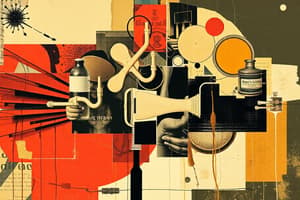Podcast
Questions and Answers
What distinguishes psychological dependence (addiction) from physical dependence?
What distinguishes psychological dependence (addiction) from physical dependence?
- Psychological dependence involves physical withdrawal symptoms upon drug cessation.
- Addiction is characterized by compulsive, relapsing drug use despite negative consequences. (correct)
- Physical dependence is defined by compulsive drug-seeking behavior.
- The primary factor is the presence of tolerance, requiring higher doses to achieve the same effect.
Which of the following is a primary mechanism by which addictive drugs exert their effects in the central nervous system (CNS)?
Which of the following is a primary mechanism by which addictive drugs exert their effects in the central nervous system (CNS)?
- Blocking serotonin reuptake in the prefrontal cortex.
- Inhibiting the release of GABA in the cerebellum.
- Decreasing dopamine (DA) levels in the mesolimbic system.
- Increasing dopamine (DA) levels in the mesolimbic system. (correct)
Pharmacokinetic tolerance involves what?
Pharmacokinetic tolerance involves what?
- Internalization of receptors in response to chronic drug exposure.
- Changes in the mu receptor that reduce its sensitivity to the drug.
- An increased number of receptors available for the drug to bind to.
- Faster removal of the drug from the body, resulting in less drug reaching the receptor. (correct)
Which of the following is a common trigger for relapse in individuals with addiction?
Which of the following is a common trigger for relapse in individuals with addiction?
What is a notable observation regarding patients treated with dopamine (DA) agonists for Parkinson’s disease?
What is a notable observation regarding patients treated with dopamine (DA) agonists for Parkinson’s disease?
Which of the following best describes drugs of abuse that typically do NOT lead to addiction?
Which of the following best describes drugs of abuse that typically do NOT lead to addiction?
Naloxone is used to treat opioid overdose because it:
Naloxone is used to treat opioid overdose because it:
How does THC, the active ingredient in marijuana, affect dopamine (DA) neurons?
How does THC, the active ingredient in marijuana, affect dopamine (DA) neurons?
Gamma-hydroxybutyric acid (GHB) is known as a 'date rape' drug because it:
Gamma-hydroxybutyric acid (GHB) is known as a 'date rape' drug because it:
Which receptor is a primary target of LSD, mescaline and psilocybin?
Which receptor is a primary target of LSD, mescaline and psilocybin?
How do benzodiazepines produce their rewarding effects?
How do benzodiazepines produce their rewarding effects?
What is the most severe potential outcome of alcohol withdrawal?
What is the most severe potential outcome of alcohol withdrawal?
Cocaine's mechanism of action in the CNS primarily involves:
Cocaine's mechanism of action in the CNS primarily involves:
In what way do amphetamines affect the levels of norepinephrine (NE) and dopamine (DA) in the brain, leading to their addictive potential?
In what way do amphetamines affect the levels of norepinephrine (NE) and dopamine (DA) in the brain, leading to their addictive potential?
How does Ecstasy (MDMA) primarily exert its psychoactive effects, contributing to its abuse potential?
How does Ecstasy (MDMA) primarily exert its psychoactive effects, contributing to its abuse potential?
Flashcards
Physical Dependence
Physical Dependence
Physical adaptation to a drug, revealed by withdrawal symptoms when drug use stops.
Addiction
Addiction
Compulsive drug use despite negative consequences, driven by feelings of euphoria and reward.
Tolerance
Tolerance
Reduced drug effect with repeated use, requiring higher doses to achieve the same effect.
Reward and Reinforcement
Reward and Reinforcement
Signup and view all the flashcards
Pharmacokinetic Tolerance
Pharmacokinetic Tolerance
Signup and view all the flashcards
Pharmacodynamic Tolerance
Pharmacodynamic Tolerance
Signup and view all the flashcards
Relapse Triggers
Relapse Triggers
Signup and view all the flashcards
Addictive Drugs Action
Addictive Drugs Action
Signup and view all the flashcards
Opioids Mechanism
Opioids Mechanism
Signup and view all the flashcards
Endocannabinoids Action
Endocannabinoids Action
Signup and view all the flashcards
THC
THC
Signup and view all the flashcards
GHB Effects
GHB Effects
Signup and view all the flashcards
Nicotine Actions
Nicotine Actions
Signup and view all the flashcards
Cocaine Mechanism
Cocaine Mechanism
Signup and view all the flashcards
Amphetamines Action
Amphetamines Action
Signup and view all the flashcards
Study Notes
- Physical dependence involves dependence.
- Psychological dependence involves addiction.
- All addictive drugs induce feelings of euphoria and reward.
- Tolerance develops that requires higher doses to achieve the same effect.
- The absence of the drug induces withdrawal.
- Dependence is defined by the signs of withdrawal.
- Addiction is compulsive, relapsing drug use despite negative consequences.
- All addictive drugs increase dopamine (DA) levels in the CNS.
- Increased DA in the mesolimbic system leads to reward and reinforcement.
Dependence, Tolerance, and Withdrawal
- Pharmacokinetic tolerance means less drug arrives at the receptor and there is a shorter duration of action at the receptor because of faster removal.
- Pharmacodynamic tolerance means changes occur in the mu receptor with receptor desensitization and internalization.
- Withdrawal is poorly understood, but signs of withdrawal indicate dependence.
Addiction a Disease of Maladaptive Learning
- Addictive individuals have relapses.
- Relapse may be triggered by re-exposure to the drug, stress, or exposure to a context that recalls prior drug use.
- Patients being treated for Parkinson's with DA agonists may become pathologic gamblers.
- DA agonists can result in 1 of 7 patients developing addiction-like behavior.
- Only a small number of dependent users progress to addiction.
- See Table 32-1 for a list of addiction potential for different drugs from a low of 1 to a high of 5.
- Note the three level classification (G protein receptor coupled, ionotropic receptor
Nonaddictive Drugs of Abuse
- Some drugs of abuse do not lead to addiction because they do not induce sensations of reward and euphoria like the hallucinogens and dissociative anesthetics.
- Examples of Nonaddictive Drugs of Abuse: LSD and PCP (angel dust).
Pharmacology of Drugs of Abuse
- All addictive drugs increase DA levels in the mesolimbic projections.
- Addictive drugs can be put into three groups:
- Act through G-protein coupled receptors; examples include: opioids, GHB, and hallucinogens (LSD, PCP).
- Act through inotropic receptors or ion channels; examples include: nicotine, alcohol, benzodiazepines, dissociative anesthetics, and some inhalants.
- Bind to monoamine transporters: examples include: cocaine, amphetamines, and ecstasy.
Drugs that Activate G10 Coupled Receptors
- Opioids inhibit adenylyl cyclase through G-protein coupled receptors.
- Naloxone reverses opioid overdose.
- Methadone or buprenorphine are used as substitutes for morphine in drug treatment programs.
Cannabinoids
- Endogenous cannabinoids (pot made by the brain) include include 2-arachidonyl glycerol and anandamide.
- These are called endocannabinoids (endogenous cannabinoids).
- Cannabinoids inhibit the release of GABA and glutamate.
- Marijuana contains the active ingredient tetrahydrocannabinal (THC).
- THC disinhibits DA neurons through inhibition of GABA neurons.
- The relative risk for addiction is low at a 2.
- Dronabinol and nabilone are two FDA-approved forms of THC used to treat a wide range of disorders including pain and nausea following chemotherapy.
Gamma-Hydroxybutyric Acid (GHB)
- GHB binds to GABAB receptors.
- GHB causes euphoria, enhanced sensory perceptions, and amnesia.
- GHB easily dissolves in alcoholic drinks and is called the "date rape" drug.
LSD, Mescaline & Psilocybin
- These induce neither dependence nor addiction.
- These often produce flashbacks up to years later.
- These increase glutamate release in the cortex.
- Another main target is the 5HT2A receptor.
Drugs That Mediate Their Effects Via Ionotropic Receptors
- Nicotine activates nicotinic Ach receptors.
- Nicotine excites projection neurons and causes release of DA, which explains potential for addiction.
- Its addictive potential is 4 on a scale of 1 to 5 (highest).
- Cytosine and varenicline are used to treat addiction because they block Ach receptors linked to DA release.
Benzodiazepines
- These a moderate risk for abuse.
- Dependence is very common.
- Addiction is rare.
- Withdrawal occurs within days after stopping the drug.
- Rewarding effects may occur because GABA receptors modulate (disinhibit) the mesolimbic DA system, resulting in reward effects.
Alcohol
- The withdrawal syndrome begins 6-12 hours after the last drink and includes tremor, nausea, vomiting, excessive sweating, agitation, and anxiety (for the alcoholic).
- 12-24 hours after the last drink visual and auditory hallucinations may occur.
- 24-48 hours after the last drink generalized seizures may occur.
- 48-72 hours after the last drink delirium tremens (alcohol withdrawal) may occur.
- Delirium tremens has a 5-15% mortality rate.
- Treatment includes supportive measures including benzodiazepines.
Ketamine & Phencyclidine (PCP)
- These were developed originally as general anesthetics.
- Only ketamine is still used as an anesthetic.
- Both ketamine and PCP are antagonists of NMDA receptors.
- Post-op patients reported vivid dreams and hallucinations.
- Both have a low potential for addiction, but long-term use can lead to psychosis closely resembling schizophrenia.
Inhalants
- These are chemical vapors with recreational use, like nitrates, ketones, and aromatic and aliphatic hydrocarbons (toluene etc).
- Sniffing is inhalation from an open container.
- Huffing is inhalation from a soaked cloth.
- Bagging is breathing in and out from a bag filled with solvent.
- The mechanism of action is not well understood.
Cocaine
- Cocaine i highly addictive (relative risk = 5).
- Heating cocaine in an alkaline solution yields free base, also known as crack cocaine.
- Crack is the form of cocaine that can be smoked.
- Cocaine blocks the reuptake of DA, 5HT, and NE within the CNS.
- Rewarding effects may come from the increase of DA in the nucleus accumbens.
- The increase in NE levels leads to increased blood pressure.
- There is no approved pharmacological treatment available for cocaine addiction.
Amphetamines
- Amphetamines cause the release of NE and DA from synaptic vesicles.
- Drugs are taken up by reuptake transporters into neurons where the drug depletes storage vesicles.
- Amphetamines are highly addictive.
Ecstasy (MDMA)
- Ecstasy is a derivative of the amphetamine-related compound methylene-dioxymethamphetamine (MDMA).
- Ecstasy is a designer drug sold at rave parties.
- Blocks 5HT reuptake.
Drugs to Learn (mechanisms of action)
- G10 Coupled Receptor: Includes opioids (morphine, naloxone, heroin, codeine, oxycodone, meperidine, methadone, or buprenorphine) and cannabinoids (marijuana, THC, hashish, dronabinol).
- Gamma hydroxybutyric acid (GHB).
- Hallucinogens: lysergic acid diethylamide (LSD), phencyclidine (PCP), ketamine, mescaline or psilocybin.
- Actions Through Ionic Channels or Ionotropic Receptors: nicotine, alcohol, benzodiazepines, dissociative anesthetics, inhalants (nitrates, ketones, or aromatic hydrocarbons), or barbiturates.
- Actions Through Monoamine Transporters (Reuptake Pumps): cocaine, amphetamines or ecstasy.
Other chemicals discussed
- rimonabant
- oxazepam
- lorazepam acamprosate (N-methyl-D-aspartate (NMDA) receptor antagonist
- naltrexone
- ethamol
- bupropion
- heroin
- codeine
- oxycodone
- meperidine
Studying That Suits You
Use AI to generate personalized quizzes and flashcards to suit your learning preferences.
Related Documents
Description
Overview of physical dependence, psychological dependence and tolerance. Addictive drugs induce euphoria and increased dopamine levels. Tolerance requires higher doses and absence of the drug induces withdrawal. Addiction causes compulsive, relapsing drug use despite negative consequences.




